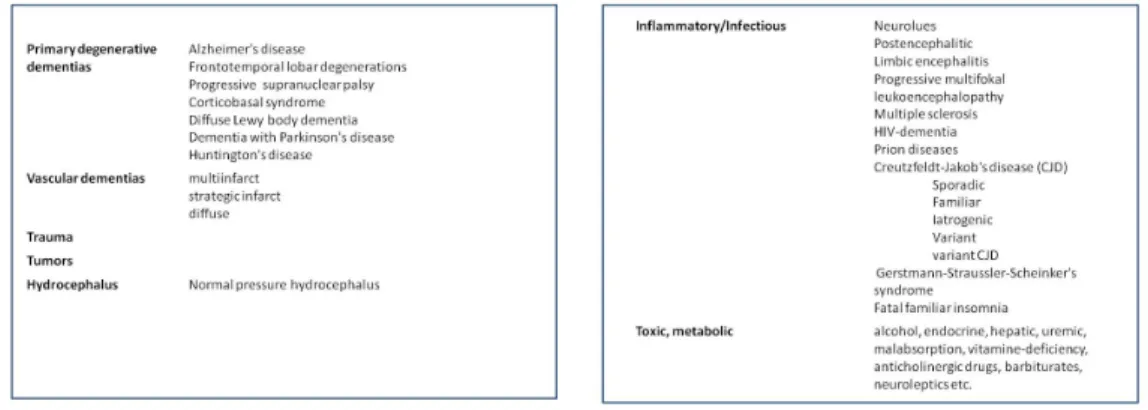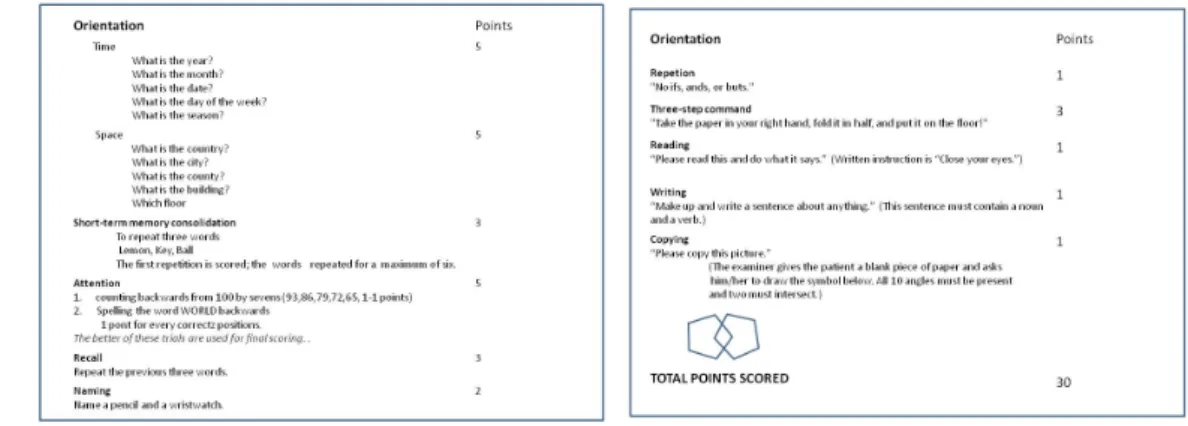III./6.1. Symptoms of dementia
Dementia is a syndrome, i.e. a combination of symptoms, which may appear in several diseases. Dementia may be secondary to other diseases or trauma affecting the nervous system or it may be the primary manifestation of degenerative nervous system disorders (Fig. 1).
Fig. 1ab: Causes of dementia
The prevalence of dementia increases with age and it doubles every five years above the age of 65 years: approximately 1% at the age of 65 years and 30% above the age of 85 years. Dementia is more frequent in women in all age groups. The population of developed countries is ageing and the proportion of elderly people is increasing, so dementia is becoming an increasingly significant economical and health problem. The number of demented patients in Europe in 2000 was approximately 7 million, which will reach about 16 million in 2050. At the same time, the number of active members of society will decrease: this ratio was 1 demented patient versus 69 active persons in 2000, and it is estimated to become 1 versus 21 by 2050. The situation in Hungary is similar;
the estimated current number of demented patients is 150,000 to 300,000.
DSM-IV criteria of dementia:
1. Memory problems
2. At least one of the following cognitive or lobar signs: aphasia, apraxia, agnosia or problems in executive functions
3. Symptoms cause problems in daily life or/and in occupation.
4. Cognitive functions were at a higher level previously
5. No disorder of consciousness associated with these symptoms
In addition to cognitive symptoms, behavioral and psychological symptoms of dementia (BPSD), such as aggression and hallucination, constitute the other major domain in dementia symptomatology. These symptoms are frequently the reason for referral, but at this time the disease is usually already in an advanced stage when therapy is less efficient.
In this chapter, only the treatment of the cognitive symptoms in specific forms of dementia is discussed. There are a number of treatment options for BPSD symptoms, most of them including the use of antidepressants and neuroleptic agents.
Dementia is a structural disease of the nervous system, thus neurological symptoms accompanying the different forms of dementia may help in differential diagnosis.
Cortical dementias are dominated by the broad spectrum of symptoms of damaged cortical areas involved in memory formation and cognitive processes, characterized by aphasia (but not dysarthria), normal cognitive speed, progressive loss of long-term
memory, early damage of short-term memory (in which cue-guiding is unhelpful), BPSD symptoms in advanced stages of the disease, absence of hyperkinesias (with the exception of myoclonus), and muscle tone disorder (rigidity or paratonia) only in late stages of the disease.
Damage of subcortical structures with cortical connections leads to dementia as well (subcortical dementia), but in this case dementia is only an accompanying symptom of the disease. Cognitive speed is slow, and dysarthria, depression, early postural changes, hyperkinesias are present, and muscle tone is increased or decreased. Cortical and subcortical features are frequently mixed and they are rarely isolated. Predominantly cortical dementia is characteristic in Alzheimer's or Creutzfeldt-Jakob's diseases, while subcortical dementia is characteristic in Parkinson's disease or in AIDS.
Fig. 2 shows the comparison of symptoms of cortical and subcortical dementias.
Fig. 2: Comparison of symptoms of cortical and subcortical dementias
When examining demented patients, it is useful to obtain the medical history of the patient and the description of symptoms both from the patient and the caregiver. It is frequently seen that the patient automatically turns towards the caregiver after asking questions from the patient (“head turning sign”).
It is important to ask about the earliest complaints and about the progression of symptoms, about changes in daily activities and occupational performance, and about the family history of dementia. Risk factors and medications should also be assessed.
The Mini Mental State Examination (MMSE) is a not too sensitive, but widely used test in dementias, especially above the age of 65, and in Alzheimer's disease (Fig. 3).
The first 10 items relate to orientation, followed by the immediate recall of three words used to test short-term memory. This is followed by the tests of prefrontal functions (serial subtraction of 7 from 100, or spelling backwards the word WORLD), which also serve to distract attention. The next item is the delayed recall of the previous three words. Language, parietal lobe functions and visuospatial abilities are assessed in the remaining part of the test.
The maximum score is 30 points, 25 or less is pathological. Mild dementia is defined as scores 25-21, moderate as 10-20, and severe as less than 10 points.
Fig. 3: Mini Mental State Examination (MMSE)
Clock-drawing test is a widely used test in which the patient is asked to put the
numbers of the clock in a circle on an empty paper, and to draw the hands of the clock to show a specific time, for example 10 minutes to two.
The detailed examination of cortical functions is also necessary.
The differentiation of dementia from other diseases may be a diagnostic challenge.
Memory problems and forgetfulness are frequent complaints. It should be emphasized that forgetfulness may also result from storage and retrieval problems of memory, which may reflect the problem of attention. Questions such as "Where are my keys?" are suggestive of attention problems and not dementia, most frequently caused by tiredness or mood disorder, especially in young patients. Depression is frequently characterized by symptoms mimicking dementia: the term pseudodementia is used to describe this entity.
It may also be difficult to differentiate dementia from delirium: delirium develops suddenly, shows marked fluctuation, is more frequent at night and characterized by a severe deficit in attention. Delirium is frequently caused by dementia, but dementia cannot be diagnosed during delirium.
About 60% of dementia above the age of 65 is caused by Alzheimer's disease (AD), while vascular dementia (VaD) accounts for about 15-20%.

